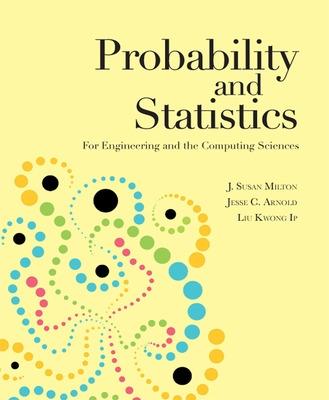This textbook helps students to understand statistical methods and reasoning as well as practice in using them. The examples and exercises are specially chosen for those looking for careers in the engineering and computing sciences. The text is intended as a first course in probability and applied statistics for students.
A set of exercises is provided throughout the text, in a section for every chapter. In addition, each chapter has a set of review exercises in which the problems are presented in random order. It is hoped that this will help the student develop the ability to recognise the appropriate analysis. Many exercises are left open-ended in hopes of stimulating some classroom discussion. The use of electronic calculators with some built-in statistical capability is encouraged, for it allows the student to concentrate on the interpretation of the analysis rather than on the arithmetic computations.
The contents of this edition focus on the applications of Statistics, rather than the mathematical details. Bearing this in mind, a section titled Real World Application has been added to three topics–Comparing Two Means and Two Variances, Analysis of Variance, and Categorical Data, for students to better relate the key concepts learned, to real cases. Another significant addition to this edition is the easy presentation of hypothesis testing. The conclusion of hypothesis testing is drawn by comparing the value of test statistic and the critical value(s), rather than the estimated P value. Moreover, hypothesis testing is presented in a “4-step format”: 1) [Hypotheses]. . . 2) [Test statistic]. . . 3) [Critical value]. . . 4) [Conclusion]. . . Nevertheless, P value is still estimated. Since the authors view statistics as an art as well as science, it is anticipated and welcomed that students disagree with the conclusion at a particular level of significance.
Some large data sets to this edition have been added to better reflect the reality students will encounter after graduation, and for students to learn to manipulate such data analysis via computer. Hence, additional essential instruction has been included, in the interpretation of statistical packages. The packages chosen for illustrative purposes are SAS and MINITAB. This was done because of their widespread availability and ease of use. Most data sets are simulated with care, so that the results of the analysis are consistent with recently reported research. This allows students to gain more insight into the type of real-world engineering problems.
In addition, more discussion of the interpretation of computer output is now included in the text. Some of the more difficult derivations have been placed in an Appendix. This gives the text a more applied flavor while preserving the material for those who are particularly interested in the mathematical foundations of the statistical concepts presented.
- ISBN13 9780071087858
- Publish Date 16 November 2012
- Publish Status Out of Print
- Out of Print 18 January 2024
- Publish Country US
- Publisher McGraw-Hill Education - Europe
- Imprint McGraw Hill Higher Education
- Format Paperback
- Pages 450
- Language English
